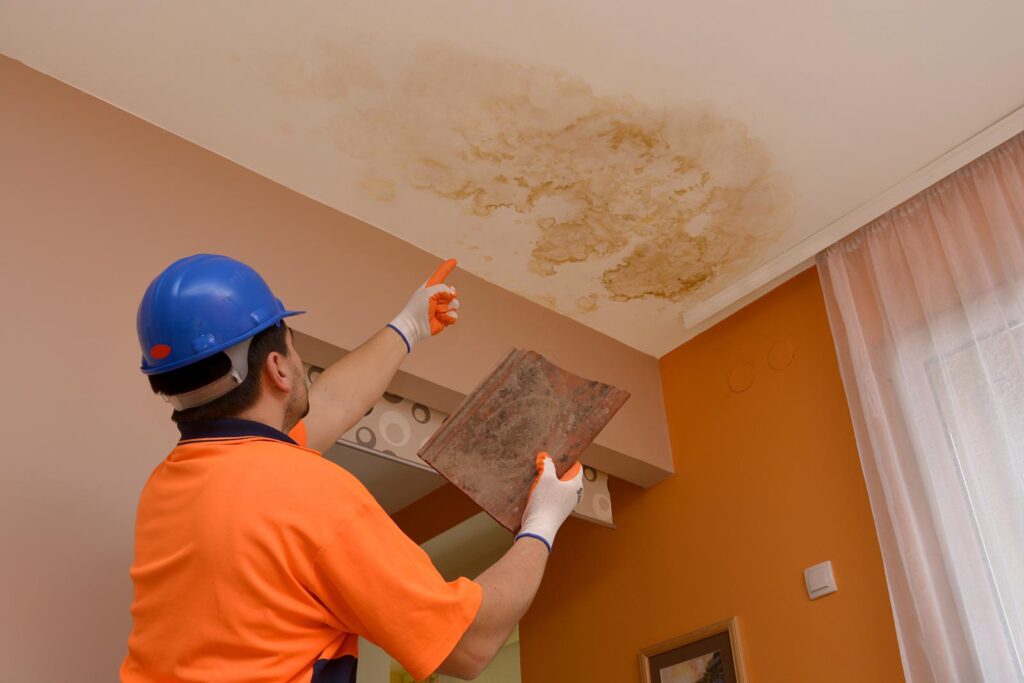
Contents
When it comes to efficient water damage repair, did you know that certain techniques can greatly speed up the restoration process? By implementing strategic methods and tools, you can effectively minimize the impact of water damage on your property. From quick water extraction to thorough drying techniques, each step plays an important role in achieving a swift restoration. Stay tuned to uncover essential tips that will help you navigate through the restoration process with ease and efficiency.
Key Takeaways
- Use moisture meters and thermal imaging to assess damage accurately.
- Employ water extraction tools promptly to remove excess water.
- Dry affected areas thoroughly with dehumidifiers and air movers.
- Salvage belongings by prioritizing and using proper drying techniques.
- Prevent future damage with regular maintenance and waterproofing measures.
Assessing the Water Damage
When inspecting water damage in your home, it’s crucial to take a systematic approach to ensure all affected areas are properly identified. Begin by checking the moisture levels in different parts of your house. Utilize a moisture meter to ascertain the extent of saturation in walls, floors, and ceilings. Elevated moisture levels indicate areas that necessitate immediate attention.
Next, perform a comprehensive damage evaluation. Look for indicators of water damage such as staining, flaking paint, or distorted surfaces. Pay careful attention to areas near plumbing fixtures, windows, and doors as these are common entry points for water. Record all visible damage with photographs to create a detailed account for insurance purposes.
After examining the visible damage, remember to inspect concealed areas as well. Water can penetrate wall cavities, beneath flooring, and into insulation, causing long-term issues if not adequately handled. Employ a thermal imaging camera to uncover hidden moisture pockets that may not be discernible to the naked eye.
Quick Water Extraction Techniques
To effectively address water damage in your residence, employing quick water removal techniques is crucial in preventing additional harm. When dealing with water damage, time is critical. Using advanced tools for water removal is essential to promptly eliminate excess water from your premises. Professional aid can also play a significant role in the restoration procedure.
Advanced tools like industrial-grade wet/dry vacuums, water pumps, and dehumidifiers are indispensable for efficient water elimination. These devices can effectively extract water from carpets, flooring, and walls, reducing the risk of mold and structural harm.
Moreover, utilizing specialized moisture detection tools can help pinpoint concealed pockets of water that may not be visible to the naked eye.
Seeking professional support from water damage restoration specialists can streamline the removal process and guarantee thorough water extraction. Skilled professionals possess the knowledge to accurately evaluate the extent of the damage and utilize the most efficient removal methods. They can also offer advice on salvageable items and help prevent additional harm to your premises.
Drying Out Affected Areas
To effectively dry out affected areas, it’s essential to dehumidify the space and use air movers strategically.
Dehumidifiers help remove excess moisture from the air, aiding in the drying process.
Air movers work to increase air circulation, expediting the evaporation of water trapped in walls, floors, and other surfaces.
Dehumidify the Space
In order to effectively address water damage, one pivotal step is to dehumidify the space, focusing on drying out the affected areas thoroughly. Proper dehumidification is essential in preventing mold growth and further damage. Here are some key tips to help you dehumidify the space efficiently:
Increase air circulation: Open windows and doors to enhance airflow, aiding in the evaporation of excess moisture.
Utilize dehumidifiers: Place dehumidifiers strategically in the affected areas to extract moisture from the air, promoting faster drying.
Use moisture removal techniques: Employ moisture-absorbing materials like silica gel or calcium chloride to help draw moisture out of the air and surfaces.
Use Air Movers
Using air movers is a pivotal step in the process of drying out affected areas after water damage. Proper positioning of air movers is vital for maximum efficiency.
Place them at 45-degree angles towards walls and verify they aren’t blowing directly at walls or furniture, but rather across the surfaces to encourage evaporation.
Regular maintenance of air movers is also significant. Clean the air mover’s filters frequently to prevent dust buildup, which can hinder airflow and reduce effectiveness. Check for any obstructions that could impede airflow and adjust the speed settings according to the level of saturation in the affected area.
Salvaging Belongings and Furniture
When salvaging belongings and furniture after water damage, it’s important to handle furniture properly to prevent further damage. Make sure to protect personal belongings by removing them from affected areas and placing them in a dry, safe location. Taking these steps promptly can help minimize losses and preserve your valued possessions.
Salvage Furniture Properly
To effectively salvage furniture after water damage, it’s important to act swiftly and methodically. Proper drying and restoration techniques can help save your cherished pieces. Follow these steps to salvage furniture properly:
Evaluation: Begin by evaluating the extent of the water damage. Identify furniture items that can be salvaged and prioritize them based on sentimental or monetary value. Remove items that are beyond repair to prevent further damage to other belongings.
Drying Process: Once you have identified salvageable pieces, start the drying process immediately. Use fans, dehumidifiers, and open windows to promote air circulation. Wipe down surfaces with a clean cloth to remove excess moisture.
Elevate furniture off wet floors using blocks or foil to prevent further water absorption.
Professional Help: For valuable or intricate pieces, consider seeking professional help for restoration. Furniture experts have the skills and tools to properly dry, clean, and repair water-damaged items, ensuring they’re restored to their former glory.
Protect Personal Belongings
To effectively protect personal belongings and salvage furniture after water damage, it’s essential to approach the task with a systematic and detail-oriented mindset. Begin by carefully evaluating the extent of the damage to your belongings. Separate salvageable items from those that are beyond repair. For belongings protection, prioritize items with sentimental or monetary value. Delicately clean and dry each salvageable item as soon as possible. Use gentle cleansers and allow ample time for thorough drying to prevent mold growth.
When it comes to furniture preservation, start by removing furniture from the affected area to a dry space. Disassemble furniture pieces if possible to aid in drying and cleaning. Wipe down all surfaces with a mild detergent to remove dirt and contaminants. Utilize fans and dehumidifiers to expedite the drying process.
Inspect furniture carefully for any signs of water damage, such as warping or mold growth. By following these steps meticulously, you can increase the chances of salvaging your personal belongings and furniture after water damage.
Addressing Mold Growth
If you notice mold growth in your home after experiencing water damage, it’s vital to address it promptly and effectively. Mold can pose health risks and spread rapidly if not dealt with correctly. Follow these steps to tackle mold growth:
Identify the Source: Begin by locating the source of moisture that’s promoting mold growth. It could be a leaky pipe, a roof leak, or inadequate ventilation. Addressing the source of moisture is pivotal to prevent mold from recurring.
Proper Ventilation: Improve ventilation in the affected areas to decrease humidity levels. Use dehumidifiers and fans to dry out the space efficiently. Proper airflow will inhibit mold growth and aid in the drying process.
Professional Remediation: In cases where the mold growth is extensive or if you have health concerns, it’s advisable to seek professional mold remediation services. Experts have the tools and knowledge to safely remove mold and prevent its recurrence.
Repairing Structural Damage
Inspecting and repairing structural damage caused by water infiltration is pivotal to restoring the integrity of your home. When addressing structural damage, start by examining the foundation for any signs of weakening or cracks. These could indicate water has compromised the stability of your home. If you notice any issues, it’s imperative to enlist the help of professionals experienced in foundation repair. They can assess the extent of the damage and recommend the appropriate solutions for structural reinforcement.
In cases where water damage has affected the structural components of your home, such as load-bearing walls or beams, swift action is necessary. These elements are essential to the overall stability of your house. Working with experts who specialize in structural repairs will safeguard that the damaged areas are properly reinforced to prevent further deterioration.
Preventing Future Water Damage
Examining your property for potential vulnerabilities and implementing proactive measures is key to preventing future water damage. By focusing on plumbing maintenance and waterproofing techniques, you can significantly reduce the risk of water-related issues in your home. Here are three essential steps to help you safeguard your property:
Regular Plumbing Inspections: Schedule annual plumbing inspections to identify and address any leaks, clogs, or signs of wear and tear in your plumbing system. Promptly fixing minor issues can prevent major water damage incidents in the future.
Proper Waterproofing: Invest in waterproofing techniques such as sealing cracks in the foundation, installing sump pumps in basements, and improving adequate drainage around your property. These measures can help keep water out and protect your home from potential flooding or water seepage.
Maintain Gutters and Downspouts: Clean gutters and downspouts regularly to ensure appropriate water flow away from your home’s foundation. Clogged gutters can lead to water backup, which may lead to water damage to your roof, walls, and foundation.
To Sum Up
After following these efficient water damage repair tips, your home will be on its way to a swift restoration like a well-oiled machine. By evaluating, extracting, drying, salvaging, addressing, repairing, and preventing, you can confirm a successful recovery process. Remember to stay proactive and diligent in your efforts to minimize the impact of water damage and create a safe and healthy living environment for you and your family.
Recent Posts
Why Choose Professional Water Extraction and Mold Cleanup?
When faced with water damage, you can’t afford to overlook the risks of mold growth.
What Are Emergency Water Extraction Services?
Water damage can strike unexpectedly, yet the right emergency water extraction services can make a
Affordable Mold Removal Services for Businesses
Did you know that mold can silently undermine your business’s health and safety standards? Ignoring
